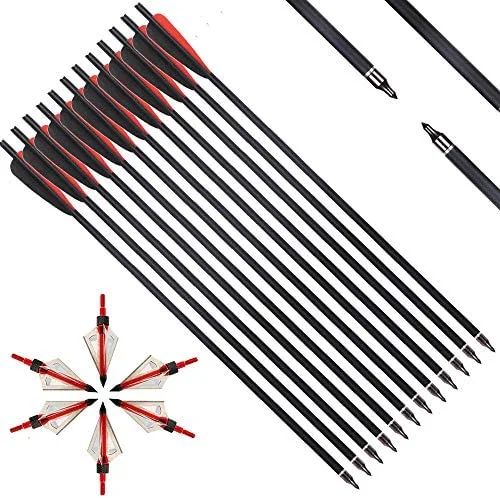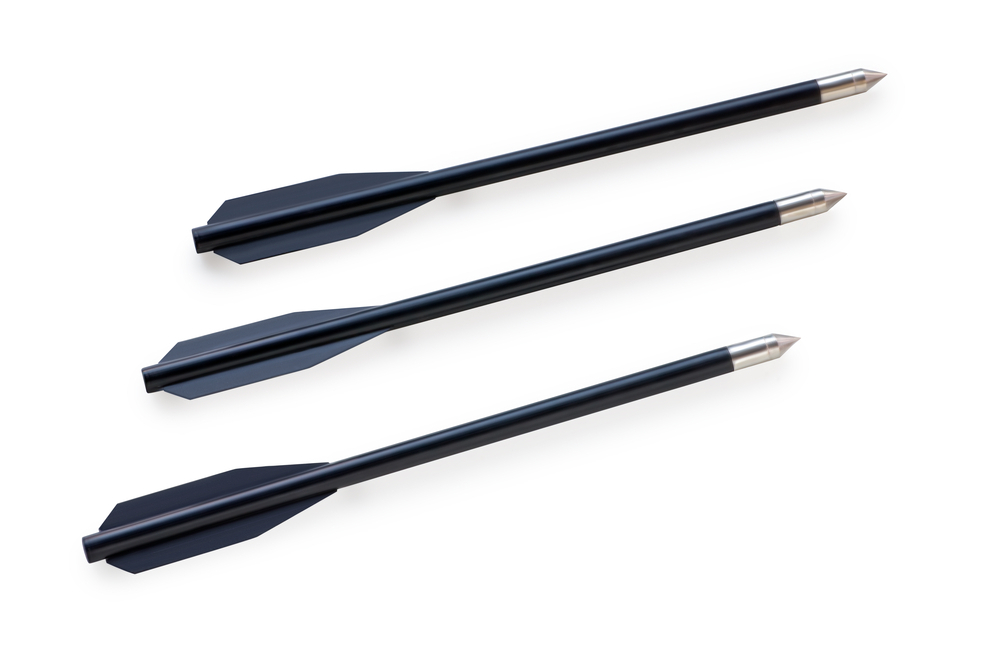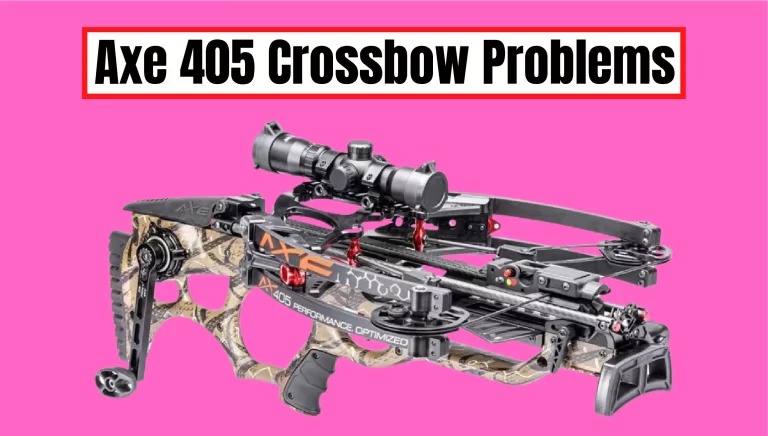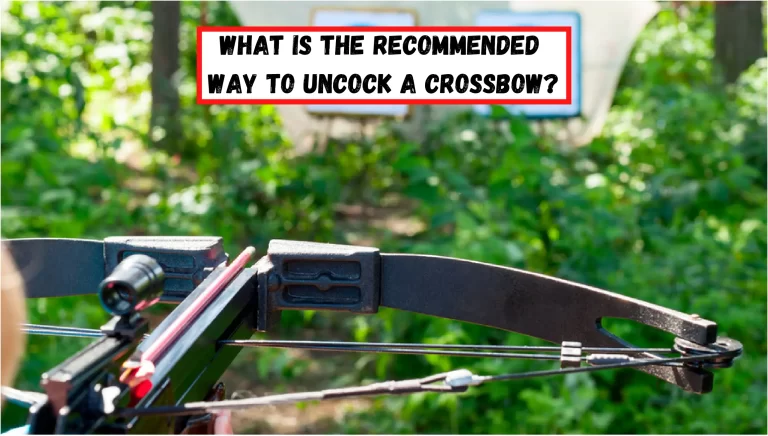How Does A Crossbow Arrow Compare To A Conventional Arrow?
"As an Amazon Associate, I earn from qualifying purchases. This post contains affiliate links"
The crossbow is a popular hunting and shooting Tool, but how does its arrow compare to a conventional arrow? In this blog post, we will explore the differences between crossbow arrows and conventional arrows and see which one is better for different purposes.
Crossbow arrows are larger and heavier than conventional arrows, with a thicker shaft and more durable fletching. They are also faster and more accurate, with a greater range and penetration power.
But are crossbow arrows always the best choice? Depending on the situation, conventional arrows may have their own advantages, such as being lighter and easier to carry in larger quantities.
Read on to find out more about the differences between these two types of arrows and how to choose the right one for your needs.
- I’ve already made an article about “ Can a Crossbow Shoot Farther Than Conventional Bows? “, which I recommend you read.
Difference Between Crossbow Bolts and Conventional Arrows

There are several key differences between crossbow arrows and conventional arrows, including their size, weight, and flight characteristics.
Size and Weight:
Crossbow arrows are typically larger and heavier than conventional arrows, with a thicker shaft and more durable fletching. This makes them more resistant to wind and other environmental factors, and allows them to deliver more kinetic energy to the target.
Conventional arrows, on the other hand, are typically smaller and lighter, with a thinner shaft and less durable fletching. This makes them easier to carry in larger quantities, but also makes them more susceptible to wind and other environmental factors.
The following table summarizes the differences in size and weight between crossbow arrows and conventional arrows:
| Crossbow Arrows | Conventional Arrows | |
|---|---|---|
| Shaft Diameter | 5/16" to 1/2" | 1/4" to 7/16" |
| Total Weight | 350 to 650 grains | 150 to 400 grains |
Flight Characteristics:
The size and weight of an arrow also affect its flight characteristics, such as its speed, accuracy, and range. Crossbow arrows are typically faster and more accurate than conventional arrows, with a greater range and penetration power. This makes them well-suited for hunting and long-range shooting.
Conventional arrows, on the other hand, are typically slower and less accurate than crossbow arrows, with a shorter range and less penetration power. This makes them better suited for target shooting and other close-range applications.
A Closer View of Crossbow Bolts

A crossbow arrow, also known as a bolt, is a type of arrow designed for use with a crossbow. It is larger, heavier, and more durable than a conventional arrow, with a thicker shaft and more durable fletching. In this article, we will explore the components, materials, size, weight, and flight characteristics of a crossbow arrow in detail.
Description of the Components of a Crossbow Arrow
A crossbow arrow consists of several key components, including the shaft, fletching, point, and nock.
The shaft is the main body of the arrow, which provides structural support and aerodynamic stability. It is typically made of carbon fiber, aluminum, or wood, and is thicker and more durable than the shaft of a conventional arrow.
The fletching is the feathered or plastic vanes attached to the shaft of the arrow, which provides lift and steerage. It is typically made of feathers or plastic and is more durable and weather-resistant than the fletching of a conventional arrow.
The point is the sharp end of the arrow, which is used to pierce the target. It is typically made of steel, and is heavier and more penetrating than the point of a conventional arrow.
The nock is the notch at the rear end of the arrow, which is used to attach the bowstring. It is typically made of plastic or brass and is more durable and weather-resistant than the nock of a conventional arrow.
Our Field-Tested Guide to the Best Fixed Blade Broadheads.
The Materials Used to Make Crossbow Arrows
The materials used to make crossbow arrows vary depending on the specific components and design of the arrow. However, most crossbow arrows are made of carbon fiber, aluminum, or wood for the shaft, feathers or plastic for the fletching, steel for the point, and plastic or brass for the nock.
These materials are chosen for their strength, durability, and resistance to weather and other environmental factors. They are also chosen for their ability to withstand the high forces generated by the crossbow and to deliver maximum kinetic energy to the target.
You Might Like to Read: How To Calculate Arrow Weight?
The Size and Weight of a Crossbow Arrow
The size and weight of a crossbow arrow vary depending on the specific design and intended use of the arrow. However, most crossbow arrows are larger and heavier than conventional arrows, with a shaft diameter of 5/16″ to 1/2″ and a total length of 16 to 22 inches.
The weight of a crossbow arrow typically ranges from 350 to 600 grains, with the heavier arrows providing more stability and power.
The size and weight of a crossbow arrow also depend on the type of crossbow it is intended to be used with, as different crossbow models may require different arrow sizes and weights for optimal performance.
It is important to match the size and weight of the arrow to the specific crossbow being used to ensure accurate shooting and to prevent damage to the crossbow or injury to the user.
Description and components of conventional bow arrows
A conventional bow arrow, also known as a traditional bow arrow or a recurve bow arrow, is a type of arrow designed for use with a traditional bow, such as a longbow or recurve bow.
Conventional bow arrows typically have a shaft made of wood, fiberglass, carbon fiber, or aluminum, and a pointed tip at one end for piercing and a fletched tail at the other end for stability in flight.
The length of a conventional bow arrow is typically determined by the height of the archer, and the weight of the arrow is chosen based on the draw weight of the bow and the intended use of the arrow.
In addition to the shaft, tip, and tail, a conventional bow arrow may also include other components such as nocks, vanes, and inserts. Nocks are small clips or notches at the back end of the arrow that are used to attach the arrow to the bowstring.
Vanes are small, lightweight feathers or plastic blades attached to the shaft of the arrow near the tail to provide stability in flight. Inserts are small sleeves or adapters that are inserted into the shaft of the arrow to provide a secure and consistent attachment point for the tip.
Overall, the components of a conventional bow arrow are designed to work together to provide accuracy, stability, and speed in flight, allowing the archer to hit their target with precision.
Which One Is More Deadly? A Crossbow Bolt Or A Recurve Bow Arrow?
It is difficult to determine which is more deadly, a crossbow bolt or a recurve bow arrow, as the lethality of a tool depends on a variety of factors, including the skill and intention of the user, the distance to the target, and the specific design of the tool.
However, in general, crossbows tend to be more powerful and have a longer effective range than traditional bows, allowing them to deliver more kinetic energy to the target and potentially cause more damage.
Crossbow bolts are also typically larger and heavier than conventional bow arrows, which can increase their penetration power.
Additionally, crossbows can be cocked and loaded in advance, allowing the user to shoot multiple bolts quickly and accurately without having to rely on the physical strength and dexterity required to draw and release a traditional bow.
On the other hand, traditional bows are often favored for their simplicity, versatility, and stealth, and skilled archers can use them to deliver precise shots at close range.
Traditional bows also have the advantage of being quieter than crossbows, which can be useful in hunting or tactical situations where noise may alert the target.
- Expert Advice: Picking the Best Crossbow for Beginners.
Which One Travels Faster? Crossbow Bolts or Conventional Arrows?
The speed at which a crossbow bolt or a conventional arrow travels will depend on a variety of factors, including the design of the bow or crossbow, the strength and skill of the user, and the weight and aerodynamics of the arrow.

In general, however, crossbows are capable of shooting bolts at higher speeds than traditional bows can shoot arrows. A typical crossbow can shoot a bolt at speeds of up to 400 feet per second, while a traditional bow may only be able to shoot an arrow at speeds of up to 300 feet per second.
The higher speed of a crossbow bolt allows it to deliver more kinetic energy to the target, potentially causing more damage. However, the speed of a crossbow bolt may also make it less accurate at longer distances, as the faster the arrow is moving, the more it is affected by wind and other factors that can cause it to deviate from its intended path.
Conclusion
In conclusion, crossbow bolts and conventional arrows are both types of projectiles designed for use with different types of bows.
Crossbow bolts are larger and heavier than conventional arrows and are typically shot at higher speeds, allowing them to deliver more kinetic energy to the target and potentially cause more damage.
However, crossbows may be less accurate at longer distances and require more physical strength and skill to operate than traditional bows.
Conventional arrows, on the other hand, are typically smaller and lighter than crossbow bolts and are shot at lower speeds. This allows them to be more accurate at longer distances and to be used with a wider range of traditional bows, including longbows and recurve bows.
However, traditional bows may not be able to deliver as much kinetic energy to the target as a crossbow, and they require a greater level of physical strength and skill to use effectively.
Overall, both crossbow bolts and conventional arrows have their own strengths and weaknesses, and the specific type of arrow that is the most effective will depend on the specific circumstances of its use.
Happy Shooting!
Related Articles:-
- What Should You do When Cocking a Crossbow?
- Is It OK to Leave a Crossbow Cocked Overnight?
- How to Aim Crossbow Elden Ring?
- Can You Do Archery in the Rain?
- What is the Recommended Way to Uncock a Crossbow?
- How Should A Hunter Safely Unload A Crossbow?
- How to Treat a Bruise from Bow String Slap?
- Why Do Archers Wear Gloves?
- Are Old Compound Bows Worth Anything?







